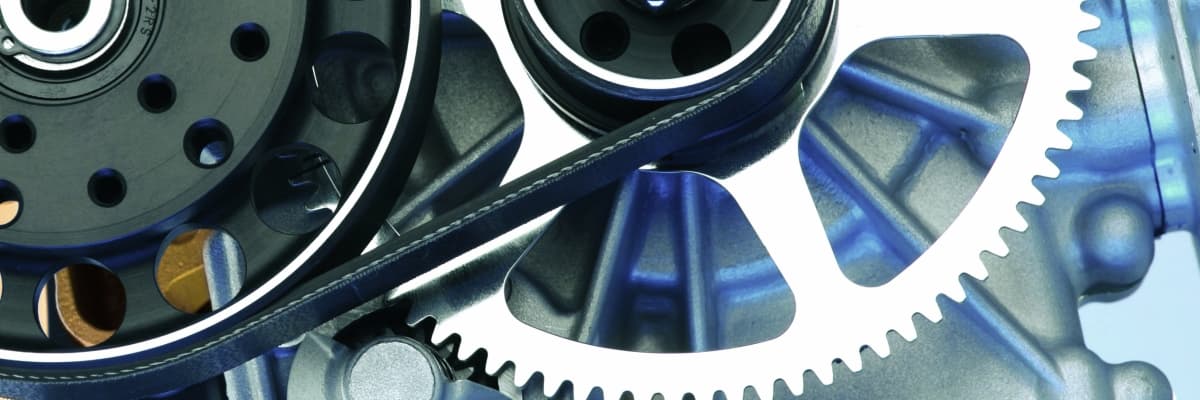Surface Belt Layers
Surface layers can be applied on V-belts, timing and flat belts to transport material or to protect the surface of belts and transported material.
The choice of surface layers depends on the type of machines and transported material, the temperature of the transported material and the ambient temperature, the size of the pulleys, etc. Specification of the surface layer is determined by the material and thickness of the layer.
Fabrics on the back and teeth can be combined with all other layers.
- Fabric on the Teeth or Back of the Belt
- Rubber Surface Layers
- Plastic Surface Layers (PVC and Polyurethane)
- Foam Surface Layers
- Special Surface Layers
Fabric on the Teeth or Back of the Belt
Special polyamide fabrics make it possible to reduce the coefficient of friction and reduce noise in high-speed drives. They are very useful in applications with sliding surfaces or in accumulation. Polyamide fabrics with antistatic properties are also available.
| Material | Maximum Temperature | Hardness | Layer Illustration | |
|---|---|---|---|---|
PAZ STANDARD (TZ11)Nylon fabric on teeth |
Nylon | - | - | 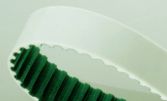 |
PAR STANDARD (TZ21)Nylon fabric on back |
Nylon | - | - | 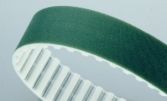 |
PAZ + PAR STANDARD (TZ11 + TZ21)Nylon fabric on teeth and back |
Nylon | - | - | 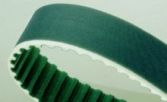 |
PAZ ANTISTATIC (TZ15)Nylon fabric on teeth |
Nylon | - | - | 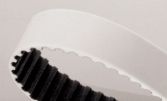 |
PAR ANTISTATIC (TZ25)Nylon fabric on back |
Nylon | - | - | 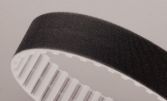 |
PAZ + PAR ANTISTATIC (TZ15 + TZ25)Nylon fabric on teeth and back |
Nylon | - | - | 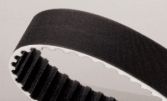 |
Rubber Surface Layers
These are surface layers of various mixtures of synthetic and natural rubbers. Thanks to the high coefficient of friction of rubber and high resistance to high temperature, they are used in many different transport applications: in the paper industry, the ceramic industry, the wood processing industry, the glass industry, on labelling and packaging machines.
| Material | Maximum Temperature | Hardness | Layer Illustration | |
|---|---|---|---|---|
NRS 035 YellowExcellent adhesion and good abrasion resistance |
Natural rubber | 65 ° C | 35 ° Shore A | 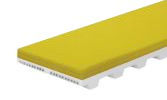 |
NRS 040 RedVery good adhesion, good resistance to abrasion and wear |
Natural rubber | 70 ° C | 40 ° Shore A | 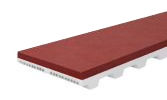 |
NRS 040 White FGVery good adhesion, good resistance to abrasion and wear, food certificate |
Natural rubber | 70 ° C | 40 ° Shore A | 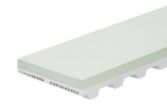 |
NRS 040 BeigeVery good adhesion, excellent for further machining, e.g. grooves, high resistance to abrasion and wear |
Synthetic rubber | 70 ° C | 40 ° Shore A | 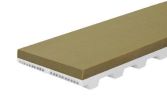 |
NRS 060 RedHigh resistance to abrasion, wear and cross section |
Natural rubber | 75 ° C | 60 ° Shore A | 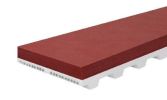 |
NRS 070 PurpleExcellent abrasion resistance, high cross-section and wear resistance |
Natural rubber | 75 ° C | 70 ° Shore A | 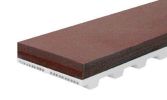 |
PBS 060 White FGResistant to oils and fats, food certificate |
Nitrile rubber | 80 ° C | 60 ° Shore A | 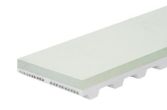 |
NTS 060 BlackVery good adhesion, resistance to abrasion at high temperatures, resistant to oils and greases |
Nitrile rubber | 110 ° C | 60 ° Shore A | 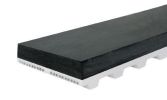 |
NTS 070 GreenResistant to oils and greases, good adhesion, fine textile structure, good resistance to abrasion and wear |
Nitrile rubber | 100 ° C | 70 ° Shore A | 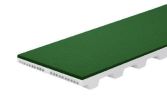 |
CXS 065 C37 BlueVery good resistance to abrasion and wear, C37 (Supergrip) structure with excellent adhesion |
Nitrile rubber | 120 ° C | 65 ° Shore A | 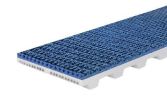 |
SRS 040 C37 OcherVery good resistance to abrasion and wear, C37 (Supergrip) structure with excellent adhesion |
Synthetic rubber | 80 ° C | 40 ° Shore A | 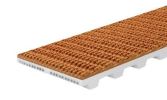 |
NTS 050 C37 RedVery good resistance to abrasion and wear, C37 (Supergrip) structure with excellent adhesion |
Nitrile rubber | 120 ° C | 50 ° Shore A | 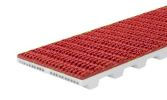 |
SRS 040 P19 WhiteGood resistance to abrasion and wear, good adhesion, P19 structure with protrusions |
Synthetic rubber | 80 ° C | 40 ° Shore A | 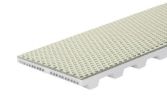 |
Plastic Surface Layers (PVC and Polyurethane)
PVC surface layers have a high coefficient of friction and good resistance to acids. Thanks to their versatility, they are used in many applications in the paper, glass, ceramic industry, in labelling and packaging equipment. They allow use in the processes of the food industry.
Polyurethane coatings of various thicknesses and hardnesses are the ideal solution in many applications in the woodworking, ceramic and glass industries. Polyurethane substrates approved for contact with food can be supplied on request.
| Material | Maximum Temperature | Hardness | Layer Illustration | |
|---|---|---|---|---|
PUS 060 BlueExcellent adhesion, flexible, very durable, extrudable |
Polyurethane | 80 ° C | 60 ° Shore A | 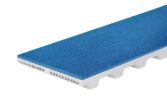 |
PUS 080 Transparent FGExcellent adhesion, resistance to abrasion, wear and cross section |
Polyurethane | 80 ° C | 80 ° Shore A | 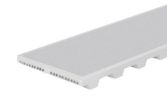 |
PUS 085 White FGExcellent adhesion, resistance to abrasion, wear and cross section |
TPU ROPANYL | 90 ° C | 85 ° Shore A | 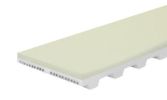 |
PUS 085 Blue AM FGGood resistance to abrasion, excellent resistance to fats and oils, antibacterial |
TPU ROPANYL | 90 ° C | 85 ° Shore A | 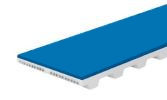 |
PUS 085 A16 Blue AM FGGood resistance to abrasion, excellent resistance to fats and oils, antibacterial, structure A16 |
TPU ROPANYL | 90 ° C | 85 ° Shore A | 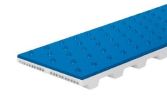 |
PUS 085 A5 Blue FGGood resistance to abrasion, excellent resistance to fats and oils, antibacterial, structure A5 |
TPU ROPANYL | 90 ° C | 85 ° Shore A | 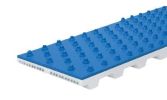 |
PUS 092 WhiteExcellent resistance to abrasion, excellent resistance to fats and oils |
Polyurethane | 90 ° C | 92 ° Shore A | 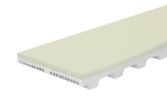 |
PUS 080/BS WhiteExcellent resistance to cross-section and wear, good resistance to oils and chemicals |
PU ROPAN BS | 80 ° C | 80 ° Shore A | 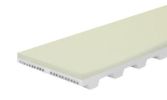 |
PVS 030 P6 GreenGood chemical resistance, excellent adhesion, P6 structure (Supergrip) |
PVC FLEXAM | 90 ° C | 30 ° Shore A | 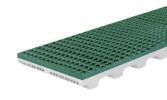 |
PVS 032 Black AS FRExcellent adhesion, antistatic, fire resistant |
PVC FLEXAM | 90 ° C | 32 ° Shore A | 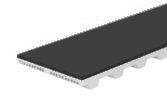 |
PVS 035 BlueExcellent adhesion, limited resistance to oils and greases |
PVC FLEXAM | 90 ° C | 35 ° Shore A | 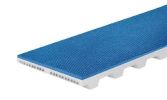 |
PVS 065 P27 White FGGood resistance to oils and fats, good chemical resistance, structure P27 (herringbone) |
PVC NONEX | 90 ° C | 65 ° Shore A | 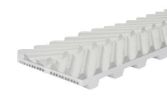 |
PVS 065 Blue FGGood resistance to oils and greases, good chemical resistance |
PVC NONEX | 90 ° C | 65 ° Shore A | 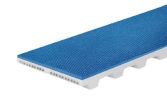 |
PVS 065 Blue AM FGGood resistance to oils and greases, good chemical resistance |
PVC NONEX | 90 ° C | 65 ° Shore A | 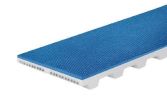 |
PVS 065 P13 WhiteGood resistance to oils and greases, good chemical resistance, structure P13 |
PVC NONEX | 90 ° C | 65 ° Shore A | 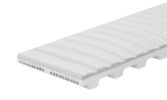 |
Foam Surface Layers
The foam surface layers are easily compressible. Due to this, its main characteristics are common applications: labelling equipment, transport of light and brittle materials, glass and paper industry, vacuum conveyors.
| Material | Maximum Temperature | Hardness | Layer Illustration | |
|---|---|---|---|---|
NRS 160 GreyPorous, very flexible and elastic, compressible |
Porous natural rubber | 65 ° C | - | 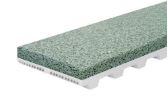 |
NRS 200 BlackPorous, good adhesion, high resistance and elasticity, compressible |
Porous natural rubber | 65 ° C | - | 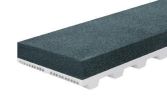 |
NRS 250 OrangePorous, leaves no traces, high durability and elasticity |
Porous natural rubber | 65 ° C | - | 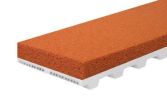 |
NRS 270 GreenPorous, good adhesion, leaves no traces, good durability |
Porous natural rubber | 65 ° C | - | 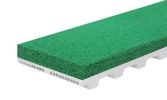 |
NES 330 BlackMicroporous, excellent adhesion, good resistance to oils and chemicals |
Porous natural rubber | 85 ° C | - | 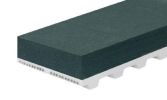 |
NES 675 BlackMicroporous, excellent adhesion, slower aging, resistant to compression |
Porous natural rubber | 100 ° C | - | 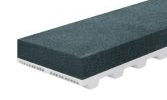 |
FBS 160 BlueMicroporous neoprene rubber coated with fabric, very low adhesion |
Textile coated porous polyurethane | 70 ° C | - | 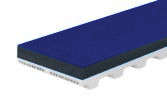 |
PUS 220 BlueLow density, almost microporous, good resistance to oils and greases |
Porous polyurethane | 70 ° C | - | 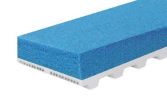 |
PUS 300 GreenMedium density, almost microporous, good abrasion resistance |
Porous polyurethane | 70 ° C | - | 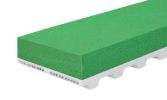 |
PUS 400 BrownHigh density, microporous, high wear resistance |
Porous polyurethane | 70 ° C | - | 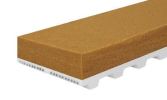 |
PUS 400 BeigeHigh density, microporous, high wear resistance |
Porous polyurethane | 80 ° C | - | 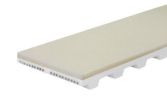 |
PUS 600 YellowVery high density, microporous, good resistance to abrasion and wear |
MikroPorous polyurethane | 70 ° C | 50 ° Shore A | 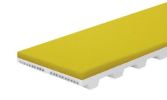 |
Special Surface Layers
Special surface layers are available in various materials to cover even the most demanding construction requirements.
| Material | Maximum Temperature | Hardness | Layer Illustration | |
|---|---|---|---|---|
PRS 060 BlueGood adhesion and abrasion resistance, can be finely extruded, silicone-free, good flexibility at low temperatures |
Thermoplastic technopolymer | 80 ° C | 60 ° Shore A | 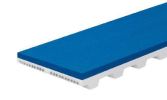 |
CLS 999 GreyHigh resistance to abrasion, medium adhesion, suitable for oily or otherwise greasy environments |
Boxcalf | 80 ° C | - | 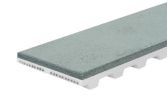 |
NPS 055 BrownLow adhesion, very good resistance to abrasion and wear |
Needle punched polyester felt | 80 ° C | - | 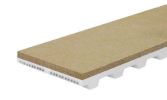 |
PAS 778 GreenLow adhesion, low fat, excellent wear resistance, resistant to grease and chemicals |
Nylon fabric | 80 ° C | - | 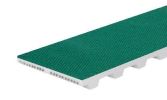 |
PLS 035 RedHigh adhesion, resistant to oils and greases, can be extruded |
PLETEX mixture | 90 ° C | 35 ° Shore A | 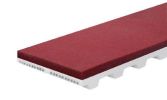 |
AMS 090 A16 IvoryGood abrasion resistance, excellent resistance to oils and greases, structure A16 |
AMTEL polyester | 100 ° C | 90 ° Shore A | 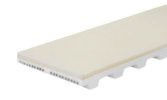 |
SLS 060 BlueGood resistance to abrasion and wear, non-stick surface |
Silicone rubber | 220 ° C | 60 ° Shore A | 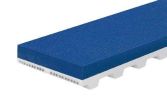 |
SLC 030 Blue FGTear resistance, excellent adhesion, non-stick surface, food certificate |
SILAM silicone rubber | 250 ° C | 30 ° Shore A | 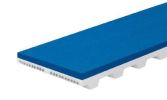 |
KFS 999 YellowTemperature resistance, good resistance to abrasion, resistance to oils and greases |
Aramid felt | 250 ° C | - | 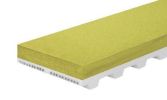 |
ELS 060 GreenGood adhesion, resistance to oils and greases, resistance to abrasion |
ELASTONYL technopolymer | 80 ° C | 60 ° Shore A | 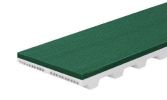 |
ELS 060 A34 GreenExcellent resistance to abrasion and wear, structure A34 (Supergrip) |
ELASTONYL technopolymer | 80 ° C | 60 ° Shore A | 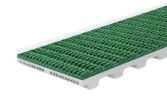 |
